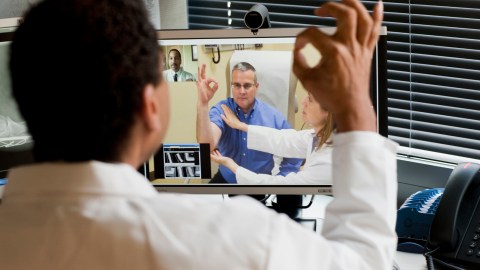Telemedicine: The future of health care is already here

- Digital technologies that disrupted industries like communication and transportation are steadily changing health care, too.
- Virtual health care will save consumers money while growing the industry by billions of dollars.
- Non-visit care combined with smartphone apps will give patients more power over their health care.
Progress in health care over the last 200 years has typically resulted from technological development, as new devices and medicines became available. Today, as technological innovation disrupts entire sectors of the economy, doctors and health care professionals are more than willing to adopt, and even promote, new approaches to health care.
Yet there is still much more room for growth. Telemedicine or “virtual check-ups” is one such area. Mobile devices and other computing advances have already drastically changed how we do business, communicate, and live our lives. The ways we receive medical care have started to follow suit.
Michael Dowling has a birds-eye view of the evolution of patient care. The president and CEO of Northwell Health, New York State’s largest health system, Dowling reflects on the availability of thousands of health-care-related apps in his recent book, Health Care Reboot: Megatrends Energizing American Medicine. He notes that some apps connect to wearables that calibrate blood pressure, heartbeat and medical implants that can monitor breathing, glucose levels or other health indicators. Many of these apps alert doctors when a patient needs a check-up, blood work or prescription changes.
All of this is resulting in a new shift toward technologically driven health care that will improve how patients are cared for. In his book, Dowling writes:
.. the in-person visit in health care—what is now the first step in many medical encounters—might be someday thought of as a last resort, after first exploring options to safely and effectively resolve a patient’s needs remotely.

Telemedicine allows A&E doctors at Dole Hospital – which doesn’t have a neurology department – to obtain an immediate diagnosis for their patient by a neurologist in Besancon hospital, seen over the doctor’s shoulder. This system allows doctors to exchange medical imagery and the patient’s file.
(Photo by: BSIP/UIG via Getty Images)
Dr. Eric Topol of the Scripps Research Institute is an ardent proponent of increasing the role of technology, especially smartphones, in the way that health professionals conduct business. In his book, The Patient Will See You Now, he emphasizes that clinicians and medical organizations need to put technological solutions at the forefront of health care strategy and delivery.
Noting that “the culture of medical practice is famously conservative,” Topol concedes that it will be a challenge, but the opportunities are too great to pass up.
Major players in the health care field are already implementing telemedicine. Dowling states in his book that:
At Kaiser Permanente, 52 percent of ‘the more than 100 million patient encounters each year are now ‘virtual visits,” via text messages, calls, email, or video conferencing.
Dowling adds that health care technology falls within two primary categories: facilitating the delivery of care and consumer interactions.
Continuing technological advancements will spur non-visit health care and improve value-based health care solutions. Companies such as Apple, Amazon, Facebook, Google, and Microsoft have already publicly expressed interest in continuing to grow their health care presence. For years, Apple has been consolidating medical records on iOS through extensive partnerships with major medical centers – including Johns Hopkins, Cedars-Sinai, and Geisinger Health System.
One of the more noteworthy entrants is Haven, a nonprofit collaboration between JP Morgan, Berkshire Hathaway, and Amazon. Haven’s goal is to improve health care services and lower costs for the three companies while making primary care easier to access.

Erica Jensen, with her 5-month-old daughter, Charlee Jaques, by her side, video conferences with her doctor, Dr. Marie McDonnell, from her mother’s home.
(Photo by Dina Rudick/The Boston Globe via Getty Images)
Amazon made another big splash last year when it announced that it had acquired PillPack, an online pharmacy. PillPack is a high-profile example of a telemedicine solution that brings the Silicon Valley spirit into the medical arena. PillPack’s digital pharmacy platform manages patient data and controls logistics for delivering and managing customers’ medical needs.
Innovations continue to unfold every day. In April 2019, Northwell Health launched an Emergency Telepsychiatry Hub that provides around-the-clock mental health care. People in crisis no longer have to wait long hours during crucial times of need. Patients have benefited from drastically reduced waiting times to speak to someone who can help them – members of an expansive team that includes 23 psychiatrists and 9 behavioral health practitioners with master’s level training
Already, the new telemedicine service has brought the wait time down 90 percent to an average of 45 minutes. Northwell is increasingly integrating these services to many of its hospitals and centers. Jonathan Merson, MD, medical director of Northwell Emergency Telepsychiatry Hub Program, stated, “It’s a technology that has no boundaries and the goal is simple: No patient experiencing a behavioral health emergency should have to wait to be seen.”
Telemedicine services are not only smart, they are also necessary. The American Association of Medical Colleges has already projected that there may be a shortage of some 40,000 primary care physicians (PCPs) in the coming decade. Increased virtual services will alleviate this shortage and allow already-overworked clinicians to focus on giving advanced care to patients in more critical situations.
Another consideration is the economic value of telemedicine services. An Accenture analysis found that the use of telehealth services could generate up to $10 billion annually over the next few years.
Without needing to expand the workforce, telemedicine can assist and augment medical professionals’ activities. Personalization and efficiency will benefit the individual patient as the tools for controlling their own medical records and care plans allow them to become more engaged.

Telemedicine is being used by rescue services in Hesse, Germany, to better treat patients in urgent conditions.
(Photo by Arne Dedert/picture alliance via Getty Images)
Telehealth is also useful for people whose frailty or chronic condition make it difficult to visit a doctor’s office. There have been significant developments in what some medical providers are calling remote patient monitoring tools. For example, smart phones or tablets of people with Type 2 diabetes can automatically log blood glucose data from their monitoring device. Physicians can check these analytics any time and adjust treatment as needed.
Telemedicine is also more efficient than office visits or house calls for non-chronic health issues. A quick follow-up by video conference can ensure a patient is following their physician’s directions. Medication management – confirming compliance with prescription doses and schedules, ensuring there are no troublesome side effects – is another helpful application of telehealth.
The technology that drives telemedicine is only in its infancy, but it will gain increasing prominence in the medical field and public sphere as innovations skyrocket and new startups enter the arena. As people grow accustomed to the ability to chat to their doctors without passing through a waiting room, to receive instant attention based on data from their medical devices, and to control their health from the palm of their hand, the life-saving convenience of telemedicine will be realized. That future is already under way.





